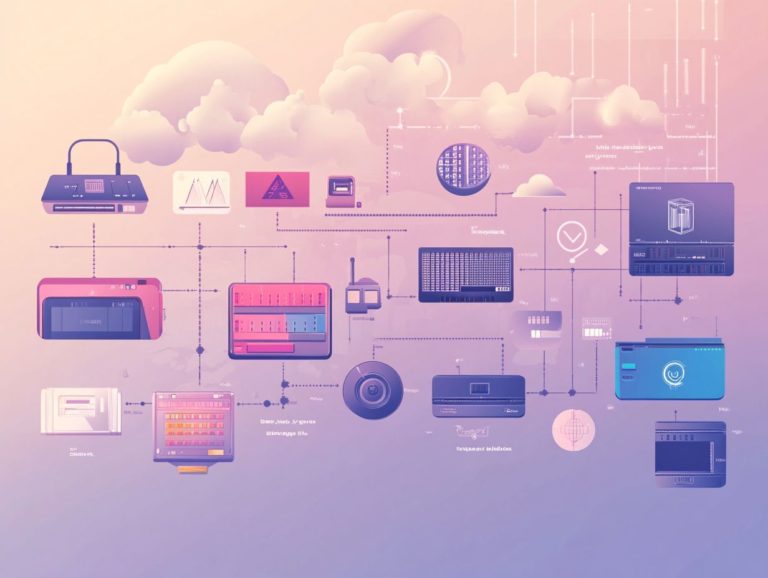Understanding Cloud Storage SLAs
In today s digital landscape, cloud storage has become vital for many businesses, making an understanding of Service Level Agreements (SLAs) essential for you.
These agreements clearly outline the expectations and commitments between service providers and users, ensuring transparency and accountability at every turn.
This text delves into the key components of a cloud storage SLA, covering everything from Service Level Objectives (SLOs) to penalty clauses.
It also explores the various types of SLAs available, dispels common misconceptions, and offers practical tips for negotiating an effective agreement.
By the end, you ll be ready to tackle cloud storage SLAs confidently!
Contents
Key Takeaways:

An SLA (Service Level Agreement) is a contract between a cloud storage provider and a customer, outlining service expectations and consequences for not meeting them.
Key components of a cloud storage SLA include Service Level Objectives (SLOs), which set the standards for service performance, and penalty clauses for non-compliance.
It is important to clarify expectations and negotiate a fair and effective SLA when using cloud storage, as different types (standard vs. customized, public vs. private) and common misconceptions can impact service delivery.
What is an SLA?
A Service Level Agreement (SLA) is your formalized contract with a service provider, setting the bar for the expected level of service. It lays out performance metrics, like uptime and response time, which are measurements of how well the service is performing.
This agreement defines key performance indicators (KPIs), accountability measures, terms and conditions, and your responsibilities as a client. These elements are essential for achieving your business objectives in a service-oriented landscape.
In essence, SLAs act as a roadmap for you and the service provider. They outline service availability requirements and establish the performance standards that must be consistently met.
SLAs are particularly crucial in cloud computing, where you depend on service providers for seamless access to resources and applications.
The typical components of an SLA include:
- Support hours
- Escalation procedures
- Penalties for non-compliance
All designed to cultivate an environment of mutual trust and reliability. By clearly defining these elements, SLAs help you avoid misunderstandings and ensure that the service quality aligns with your operational needs, ultimately leading to enhanced satisfaction.
Key Components of a Cloud Storage SLA
The key components of a cloud storage Service Level Agreement (SLA) include critical performance metrics like uptime, response time, and resolution time.
These elements ensure that the service provider adheres to the agreed-upon security standards and disaster recovery protocols, all designed to meet your customer service expectations.
Service Level Objectives (SLOs)

Service Level Objectives (SLOs) are essential elements of Service Level Agreements (SLAs), outlining specific performance metrics that you, as a service provider, must achieve to meet your customers’ expectations regarding service delivery.
These objectives function not just as benchmarks for assessing your reliability but also play a pivotal role in enhancing overall customer satisfaction.
Various types of SLOs exist, including those centered on key performance indicators such as service availability, which measures uptime, and response time, which tracks how quickly you address customer inquiries.
By diligently monitoring these metrics, you can gain valuable insights into your service quality, identify areas needing improvement, and ensure that you consistently meet or even exceed your customers’ expectations.
Ultimately, well-defined SLOs promote transparency and accountability, strengthening the trust between you and your clients.
Penalty and Compensation Clauses
Penalty and compensation clauses in SLAs define the money penalties service providers face when they fail to meet the agreed-upon performance standards. These clauses offer service credits or impose penalties in instances of non-compliance, ensuring that there are clear stakes involved.
These provisions are crucial in fostering accountability among service providers. They compel providers to honor their commitments and maintain a consistent level of service quality. By explicitly outlining the repercussions of underperformance, these clauses facilitate proactive engagement between the service provider and your customer service team, ultimately enhancing interactions and elevating satisfaction levels.
When service providers understand the importance of following SLAs, it leads to improved operational standards and reliability. This not only reinforces the overall effectiveness of customer support but also boosts client confidence in the partnership, creating a win-win situation for everyone involved.
Types of Cloud Storage SLAs
Cloud storage SLAs come in various forms, including Standard SLAs and Customized SLAs. To better understand these agreements, it’s helpful to know what Cloud SLAs are. Each type is meticulously crafted to meet distinct client needs and aligns seamlessly with the service provider’s offerings in both Public and Private Cloud environments.
Standard vs. Customized SLAs

Standard SLAs offer a generic framework for service delivery. In contrast, Customized SLAs are crafted specifically to align with your unique expectations and service needs, ensuring that performance metrics resonate with your business objectives.
This difference can greatly affect your satisfaction and the accountability of service providers. Standard SLAs generally include broad service tracking metrics and predefined escalation procedures, which might not cater to the specific needs of every client.
Customized SLAs provide flexibility in turnaround times and specific performance indicators that closely match your operational requirements. While the uniformity of standard agreements promotes clarity, their rigid structure may not deliver the same level of satisfaction as a tailored approach.
Ultimately, both types of SLAs come with their own advantages and disadvantages. Your choice can significantly influence how effectively your needs are met.
Public vs. Private Cloud SLAs
Public Cloud SLAs tend to be more standardized, catering to a diverse array of clients. In contrast, Private Cloud SLAs often feature tailored service agreements emphasizing enhanced security standards and data management customized to your specific needs.
This distinction underscores how each service model approaches accountability and service quality in its unique way. For instance, public cloud providers usually adhere to a uniform set of performance metrics, which may not fully align with your distinct operational demands.
Private cloud service providers grapple with the challenge of meeting bespoke expectations that can vary widely from one client to another. As a result, public cloud SLAs prioritize scalability and cost-efficiency, while private cloud SLAs focus on strict compliance with security protocols and personalized support.
This dynamic makes it essential for service providers to skillfully navigate these complexities to truly meet your requirements.
Common Misconceptions About Cloud Storage SLAs
Common misconceptions about cloud storage SLAs can create significant misunderstandings about the quality of service, accountability, and the true nature of your responsibilities within the contractual agreement with your service providers. It’s important to delve into understanding hybrid cloud SLAs to clarify these aspects.
It’s essential to grasp the nuances of these agreements to ensure you are fully informed and prepared for the expectations they entail.
Clarifying Expectations

Clarifying expectations is crucial for you and your service provider. It ensures that everyone understands what to expect and what each party must do regarding the Service Level Agreement (SLA). This shared understanding forms the foundation of effective service management and accountability.
By establishing clear communication channels, you can express your needs while the service provider shares their capabilities. Miscommunication can lead to serious repercussions, including a decline in service quality and a breakdown of trust, ultimately threatening the relationship between both parties.
Setting realistic expectations minimizes risks and cultivates a collaborative environment where both you and the service provider work toward shared objectives. This fosters a productive partnership grounded in accountability and mutual respect.
Negotiating and Reviewing a Cloud Storage SLA
Negotiating and reviewing a Cloud Storage SLA is an essential process that gives you the power to ensure your service agreements align with your business objectives. For a deeper insight into this topic, understanding SLA differences among cloud providers can safeguard your interests and hold service providers accountable for their performance metrics.
Tips for Ensuring a Fair and Effective SLA
Ensuring a fair and effective Service Level Agreement (SLA) demands careful negotiation, clear communication, and a deep understanding of performance metrics to align client expectations with service provider capabilities.
Weaving transparency into the process creates a clearer picture of what is expected and what can realistically be delivered. Performance tracking tools are essential, enabling real-time assessment of service quality and accountability.
Make regular reviews a priority to keep the SLA relevant, ensuring it evolves alongside your business goals and adapts to changing circumstances.
This proactive strategy cultivates trust and nurtures a collaborative environment where both you and the service provider strive for mutual success, ultimately enhancing service delivery and customer satisfaction.
Frequently Asked Questions
- What is meant by SLA in the context of cloud storage? SLA stands for Service Level Agreement. It is a contract between a cloud storage provider and its customers that outlines the level of service and performance that is guaranteed to be provided.
- Why is it important to understand cloud storage SLAs? Understanding cloud storage SLAs is important because it helps manage expectations and ensure that the storage service meets your business needs. It also helps avoid any potential conflicts or misunderstandings between the provider and customer.
- What are some common components of a cloud storage SLA? Common components include uptime guarantees, data availability and durability guarantees, data security and privacy policies, and performance metrics such as latency and throughput.
- What are the consequences of not meeting the SLA? If a cloud storage provider fails to meet the SLA terms, the customer may be entitled to compensation or credit for the downtime or performance issues experienced. Specific consequences will depend on the SLA’s terms and conditions.
- How can I ensure that the SLA meets my business needs? Before signing an SLA, thoroughly review and negotiate the terms to ensure they align with your business needs. This may involve seeking clarification from the provider or requesting modifications.
- Can SLAs be changed or updated over time? Yes, SLAs can be changed, especially as technology and business needs evolve. However, any changes should be mutually agreed upon and clearly outlined in the SLA to avoid conflicts or misunderstandings.
Start your negotiation process today for better cloud storage!






